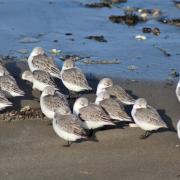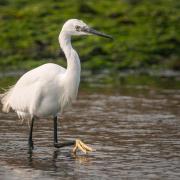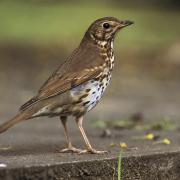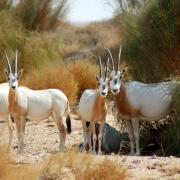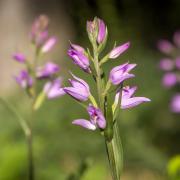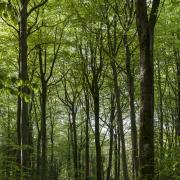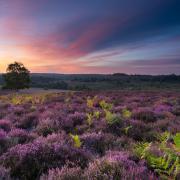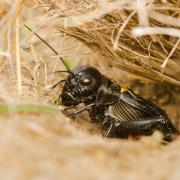Blashford Lakes near Ringwood is the latest reincarnation of a landscape with a chequered past

Pulling into the car park at Blashford Lakes nature reserve, the time's nudging 9am. Yet the sound of bird cries filling the air is a reminder that there are plenty of early risers around here. For the uninitiated hopeful of getting a glimpse of some of these residents, however transient, one tactic would seem to be to try the wooden door of the newly rebuilt Tern Hide. And, incredibly, as if walking through Narnia's magical portal, a whole new world flows into view.
Today, Ibsley Water, the largest freshwater body of water in Hampshire, is fringed by shallow foreshores and a necklace of trees. A transformation that's almost impossible to imagine, given the changes in land use witnessed across the 150 hectare site over the centuries. From what was once fields, it went on to become an RAF base for Spitfire squadrons during World War II, and a motor racing circuit. Now managed by Hampshire & Isle of Wight Wildlife Trust, on behalf of Wessex and Bournemouth Water, the lake is one of several created over the past couple of decades by flooding the gravel pits that more recently scarred the countryside.
Fully protected from the elements, a wall of glass within the hide provides the chance to marvel at the diversity of waterfowl attracted to this carefully conserved habitat. With the coot topping the leader board of recently spotted species, it's not unsurprising to see one almost within touching distance, entertaining with a series of dives that would make the GB synchronised swimming team proud. But seated with flaps lifted to accommodate binoculars and telephoto camera lenses, several more seasoned birdwatchers continue to scan the skies and land. The convivial church-like silence is broken when a call goes up and all eyes turn as three cormorants are sighted, plus a couple of, as yet, unidentified wading birds. Venturing to interrupt photographer Mike who "probably expects to be here for a couple of hours", there's confirmation of a good chance of seeing "something interesting", on even the greyest of days.
Having worked at Blashford Lakes for more than 15 years, Jim Day, the Wildlife Trust's education officer, also admits to being drawn to this particular spot. "It's the first place that I go to when I open up in the morning. "The previous hide was smaller and more traditional. For the regular birders it's a really special view. And as this is one of the main entrances to the reserve, we wanted to make the new one more inviting to people who may not already be switched-on to wildlife.

"What makes this reserve so special is the variety of different wildlife habitats. Sandwiched between the River Avon and the New Forest, it's a wildlife corridor and the 'perfect storm' really, with everything coming together in one place: there's grassland, a lichen heath, a river passing through the site, ancient woodland and, of course, the lakes. It's a classic example of how, given a helping hand, nature recovers."
And, in addition to the small Wildlife Trust team based here, they have he says "an army of conservation volunteers" to ensure that the biodiversity is sensitively maintained and developed. With Thursdays dedicated to tackling some of the larger scale tasks on site, the first Sunday in every month also sees more regular volunteers getting hands-on with seasonal jobs.
As Jim points out, every day the wildlife here is different. In fact, as the mercury and hours of daylight fall, Blashford Lakes turns into a hotspot for species escaping the harsher climates of the frozen north.
No sooner has the house martin, the common sandpiper and even the occasional osprey departed with autumn, next to stop-off on this migratory highway are huge flocks of overwintering birds on the search for somewhere to feed and roost. Among them being the gadwall, pochard, shoveler and wigeon. And, if they're lucky, the great white egret or bittern.
Wildlife-watching, whether looking for visiting birds within different habitats or native mammals, such as otters, is made easier using the well-placed hides and viewing screens dotted throughout the reserve.
"I like to go to the Lapwing Hide at the end of the day," says Jim. "There may be thousands of gulls all over the water and it's another amazing panoramic view," adding: "I also like anywhere along the Dockens Water river which is where the sea trout arrive after heavy rains. There are always things to see around the pond too; it's a real suntrap and attracts the insects."
The wildlife pond with its boardwalk and covered picnic area, the new Tern Hide, and a small sensory garden are just a few of the more recent additions to the reserve, thanks to rural development funding from LEADER and Veolia Environmental Trust. A welcome hut, resplendent with sedum roof, is, he continues, all part of the effort to open up the area to more people.
"Our welcome volunteers have also been a new addition this year. They are here at weekends and on bank holidays which is brilliant for both regulars and new visitors alike. Because people, generally, aren't so engaged with wildlife, for some, coming here it's that lightbulb moment."
While it is very easy to over-hype the ready distractions of the digital age, the ability of the natural world to make a positive difference to people's lives is not underestimated at Blashford Lakes. "We run special programmes and offer work experience for young adults," says Jim. "And I desperately want children to have the opportunity to experience nature and to encourage them to discover their local green space. It's why I do my job."






